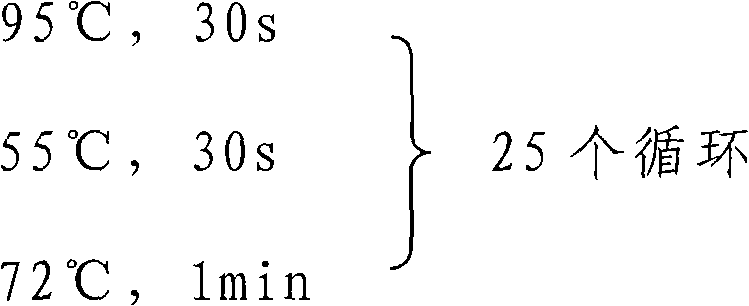Bioengineering method for synthesis of citicoline
A citicoline, bioengineering technology, applied in the direction of microorganism-based methods, biochemical equipment and methods, botany equipment and methods, etc., to achieve the effect of improving controllability
- Summary
- Abstract
- Description
- Claims
- Application Information
AI Technical Summary
Problems solved by technology
Method used
Image
Examples
Embodiment 1
[0012] Streptococcus pneumoniae sample RNA was extracted by conventional methods, and cDNA of Streptococcus pneumoniae was obtained by reverse transcription. Using the primers described in Claim 6 as primers, the CCT gene was fished out from the cDNA of Streptococcus pneumoniae by using the PCR method. The specific PCR conditions are:
[0013] 95℃, 5min;
[0014]
[0015] 72℃, 10min
[0016] The product was detected by agarose gel electrophoresis, and the size was 690bp, which was consistent with the prediction. The above CCT gene was digested with restriction endonucleases NdeI and XhoI, and after recovery, it was ligated with the vector pET28a digested with NdeI and XhoI, transformed into Escherichia coli, and the transformant with kanamycin resistance was screened. After plasmid extraction and enzyme digestion identification, it was proved that the recombinant protein CCT gene had been cloned into pET28a.
[0017] with CaCl 2 The pET28a-CCT was transformed into BL21...
Embodiment 2
[0019] The recombinant engineered bacterium gained in embodiment 1 inserts culture medium according to 2% inoculum (containing tryptone 10g / L, yeast extract 10g / L, K 2 HPO 4 ·3H 2 O 15g / L, NaH 2 PO 4 2H 2 O 10g / L, 1ml defoamer. Sterilize at 121°C for 20 minutes, add kanamycin to a final concentration of 50 mg / L before inoculation, and sterile MgSO 4 To a final concentration of 0.8g / L, sterile glucose to a final concentration of 2g / L, a sterile trace element concentrate 10ml / L, and the pH value adjusted to 6.55) in a 5L fermenter for fed-batch high-density fermentation, the pH value Controlled at 6.55±0.05, after 5 hours of incubation at 37°C, the working concentration of IPTG induction was 0.1mM. After 20 hours of induction, the bacteria were collected by centrifugation and stored in a -20°C refrigerator for future use.
Embodiment 3
[0021] Weigh 10 g of the bacterium obtained in Example 2, dilute to 100 g / L with phosphate buffer, place in an ice-water bath, use an ultrasonic cell disruptor, set the ultrasonic power to 30%, work for 4 seconds and stop for 6 seconds, cycle 1 Hour, obtain 100ml bacteriostasis liquid. It was centrifuged at 4° C. and 12000 rpm for 1 hour, and the centrifuged supernatant was collected. Load the sample to a nickel affinity chromatography column (2.6 / 10cm) that has been equilibrated with 50mM phosphate buffer, equilibrate the column with the same buffer, and elute the impurity on the column with a buffer containing 20mM imidazole , and finally the target protein on the column was eluted with a buffer containing 300 mM imidazole, the eluate was collected, dialyzed with 20 mM phosphate buffer, and freeze-dried to obtain a recombinant phosphorylcholine cytidine transferase preparation. Measure the concentration and specific activity of the enzyme preparation, and store it in a -20°...
PUM
 Login to View More
Login to View More Abstract
Description
Claims
Application Information
 Login to View More
Login to View More - R&D
- Intellectual Property
- Life Sciences
- Materials
- Tech Scout
- Unparalleled Data Quality
- Higher Quality Content
- 60% Fewer Hallucinations
Browse by: Latest US Patents, China's latest patents, Technical Efficacy Thesaurus, Application Domain, Technology Topic, Popular Technical Reports.
© 2025 PatSnap. All rights reserved.Legal|Privacy policy|Modern Slavery Act Transparency Statement|Sitemap|About US| Contact US: help@patsnap.com



